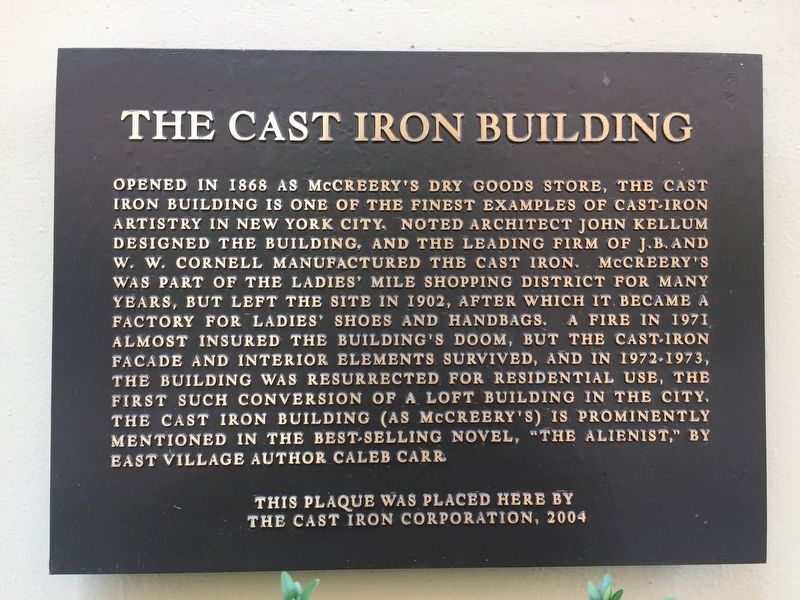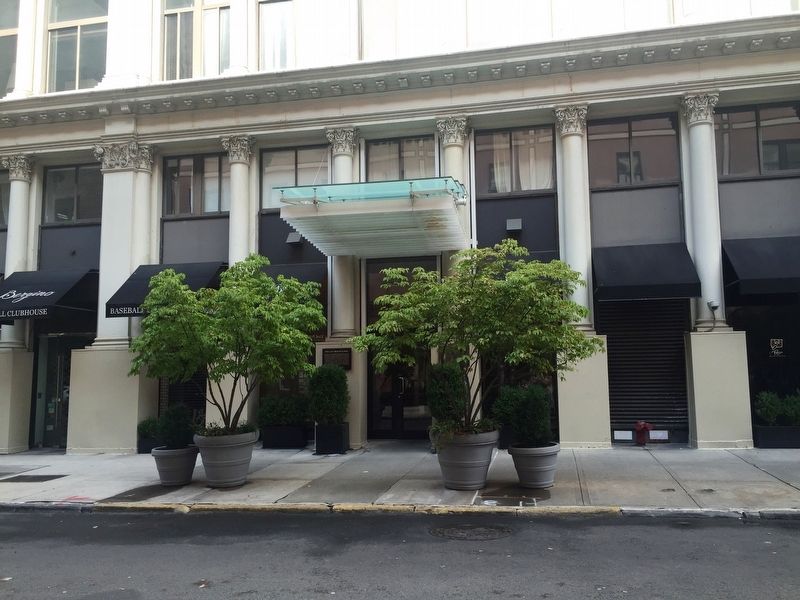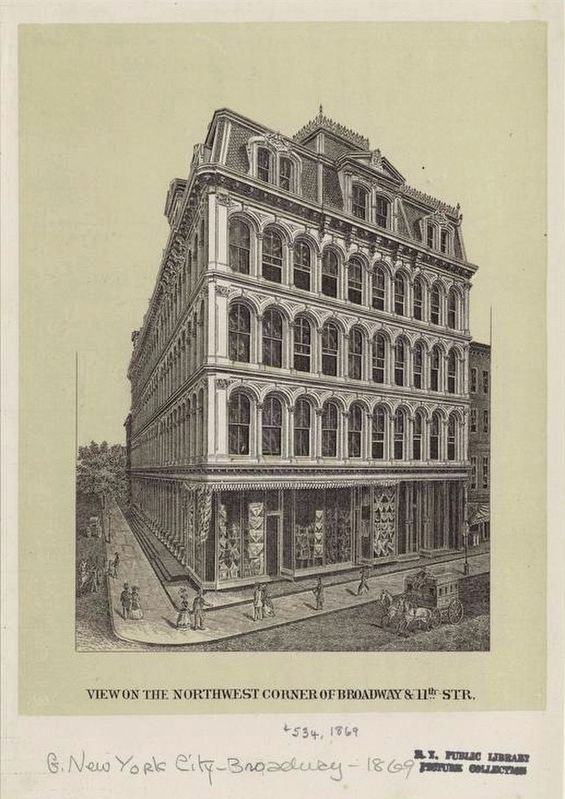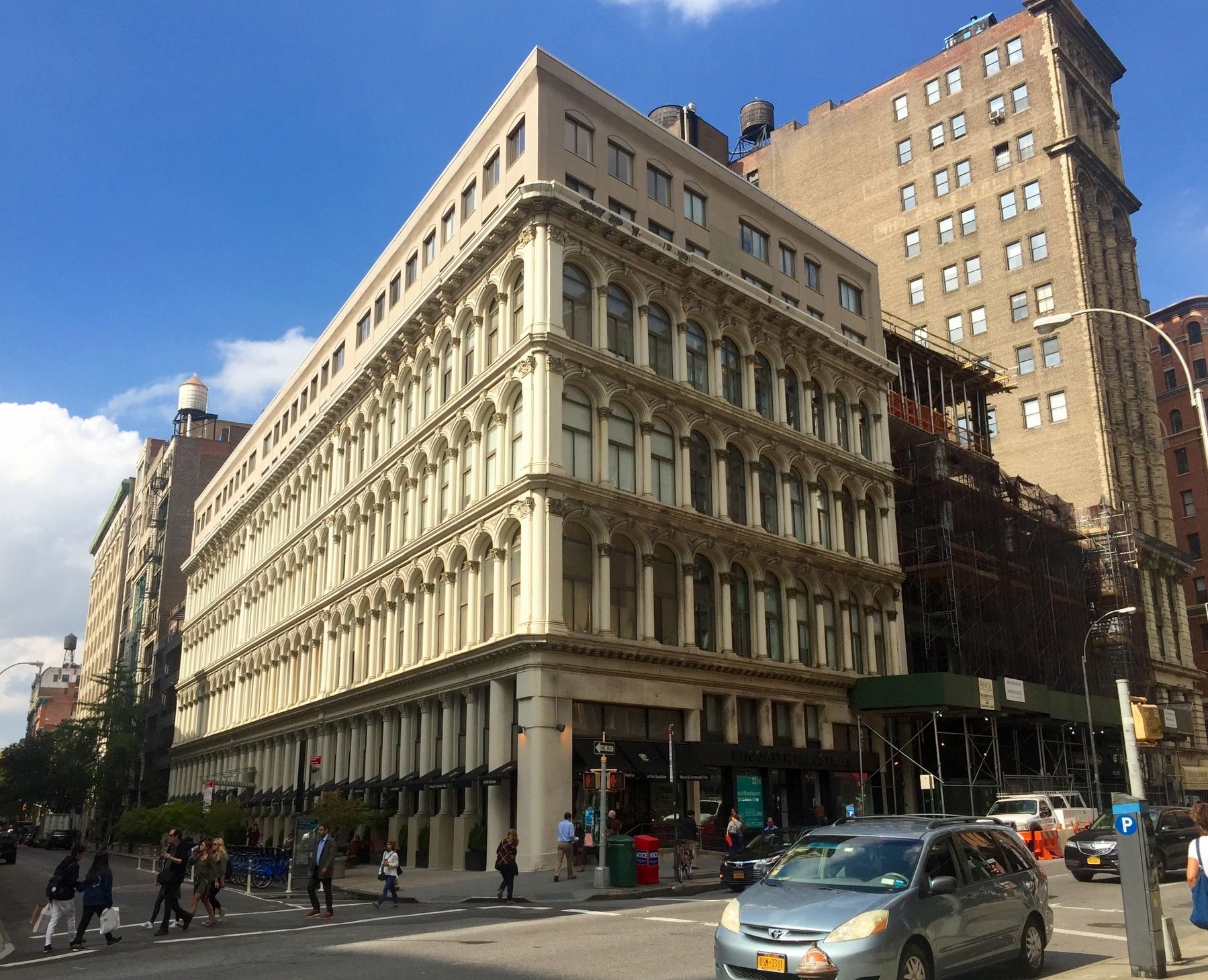Greenwich Village in Manhattan in New York County, New York — The American Northeast (Mid-Atlantic)
The Cast Iron Building
Opened in 1868 as McCreery's Dry Goods Store, the Cast Iron Building is one of the finest examples of cast-iron artistry in New York City. Noted architect John Kellum designed the building and the leading firm of J.B. and W.W. Cornell manufactured the cast iron. McCreery's was part of the Ladies' Mile Shopping District for many years, but left the site in 1902, after which it became a factory for ladies' shoes and handbags. A fire in 1971 almost insured the building's doom, but the cast-iron facade and interior elements survived, and in 1972-1973 the building was resurrected for residential use., the first such conversion of a loft building in the city. The Cast Iron Building (as McCreery's) is prominently mentioned in the best-selling novel, "The Alienist," by East Village author Caleb Carr.
The Cast Iron Corporation, 2004.
Erected 2004 by The Cast Iron Corporation.
Topics. This historical marker is listed in these topic lists: Architecture • Industry & Commerce. A significant historical year for this entry is 1868.
Location. 40° 43.964′ N, 73° 59.506′ W. Marker is in Manhattan, New York, in New York County. It is in Greenwich Village. Marker is at the intersection of East 11th Street and Broadway, on the left when traveling east on East 11th Street. Touch for map. Marker is at or near this postal address: 67 East 11th Street, New York NY 10003, United States of America. Touch for directions.
Other nearby markers. At least 8 other markers are within walking distance of this marker. Grace Church (about 300 feet away, measured in a direct line); 830 Broadway (about 300 feet away); Police Athletic League Building (about 400 feet away); 832-834 Broadway (about 400 feet away); The Hotel Albert (about 400 feet away); International Tailoring Company Building (about 500 feet away); Frank O'Hara (about 500 feet away); The Petersfield (about 500 feet away). Touch for a list and map of all markers in Manhattan.
Regarding The Cast Iron Building. The building is listed in the “American Institute of Architecture (AIA) Guide to New York City, Fifth Edition”.
Also see . . . The 1868 McCreery & Co Dry Goods Store - 801 Broadway. Daytonian in Manhattan website entry:
"In 1868, three years after the end of the Civil War, the new James McCreery & Co. Dry Goods opened its magnificent emporium on Broadway at 11th Street. Designed by John Kellum, the five-story French Second Empire building was the latest in architectural fashion, the style originating in Paris only about a decade earlier. Kellum used the relatively new technology of a pre-fabricated cast iron façade which, while being fire-proof, allowed for the ample use of large windows. Vast glass show windows
lined the street level while a striking mansard roof with lacy cresting and French dormers capped the building....
Constructed by builders J. B. and W. W. Cornell, the lavish store cost a staggering $300,000....
McCreery had chosen a highly-fashionable area for his new building. Across Broadway was the Episcopal Grace Church where, for twenty years, New York’s wealthy had worshipped and were married. Across 11th Street to the south was the first-class St. Denis Hotel, opened in 1853, and the side streets were lined with grand brownstone residences....Focusing on the female shopper, the store catered to the monied carriage trade. Before long The New York Times would deem it "one of the most highly esteemed dry goods establishments in America." In 1872 the newspaper commented on the store's goods. “Shawls, silks and furs, of good quality, and specially suited to the season, may be obtained at McCreery & Co.’s establishment, Broadway and Eleventh-street. They have recently added largely to their stocks, and now offer a fine selection of goods intended for ladies’ use.”... (Submitted on October 18, 2016.)
Credits. This page was last revised on January 31, 2023. It was originally submitted on October 18, 2016, by Andrew Ruppenstein of Lamorinda, California. This page has been viewed 531 times since then and 83 times this year. Last updated on April 12, 2020, by Larry Gertner of New York, New York. Photos: 1, 2, 3, 4. submitted on October 18, 2016, by Andrew Ruppenstein of Lamorinda, California. • Bill Pfingsten was the editor who published this page.



